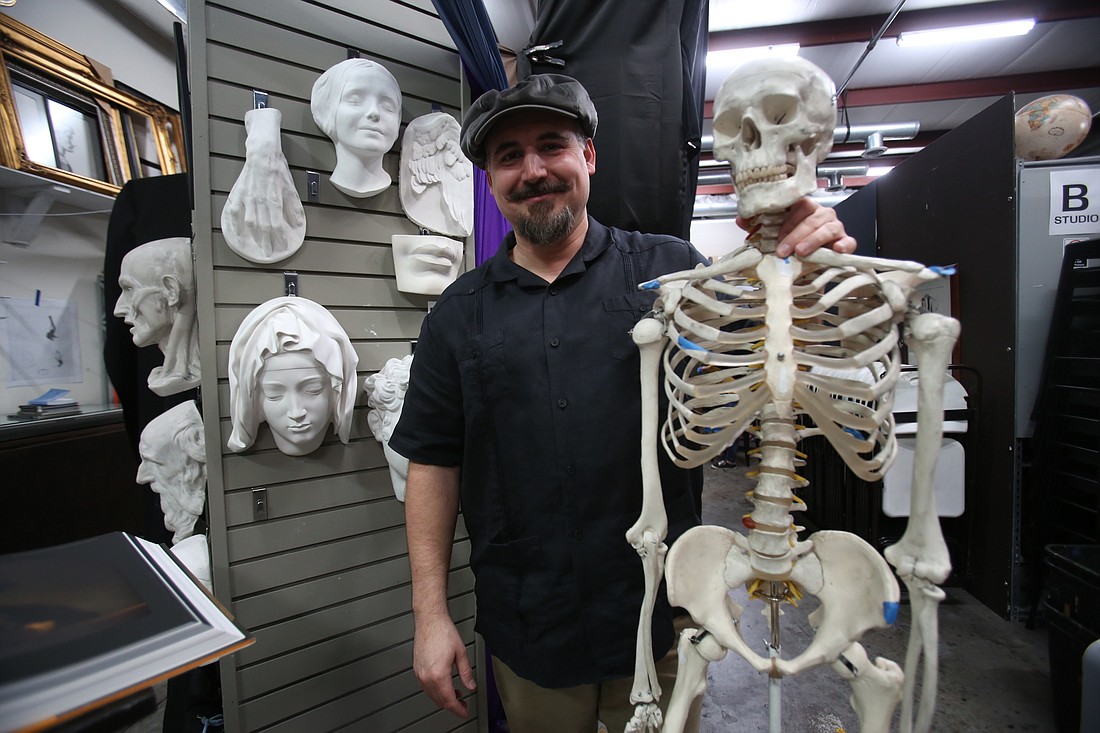- May 5, 2025
-
-
Loading

Loading

Charles Miano loves the moment when he walks into his art studio each morning.
He’s met with a familiar sight more often than not — a number of diligent apprentices already hard at work at their easels painting realistic depictions of the human form.
Sometimes they make accurate portrayals of masks or skeletal frames, other times they’re working with live models in the studio.
It’s quiet but focused, and that’s how Miano likes it.
“I get to come into a space where we walk back in time,” Miano says.
Miano is the founder of the Southern Atelier, a fine art center focused on teaching classical principles and realism in paintings, drawings and sculptures. Artists at the studio learn the representational craft by way of long-term apprenticeships under Miano’s watchful eye.
It’s an approach that emphasizes a hands-on approach and plenty of time working in the studio that’s very much part of the Renaissance style— something Miano believes has been lost in modern classroom learning.
“(The studio) is coming from a place of advocacy, not a place of ‘This is better than that,'” Miano says. “It’s just advocating for something that’s been lost. It’s a niche part of the art world we’re involved in.”
Miano comes from an artistic family with a father that makes art and plays music as well. He thought he’d be a musician like his dad but ended up gravitating toward the visual arts.
What kind of art to pursue was a more open question, but Miano eventually found his idols.
He worked at a publishing company in New York where he was mentored by other artists, particularly those who revered the Dutch painter Rembrandt.
It was then he started becoming interested in the atelier —a French term meaning "artist's workshop" — style of art teaching.
He felt drawing and painting realistic representations of people had fallen out of vogue with the rise of abstract expressionism and the modernist movement in the 20th century.
This somewhat-lost style, especially compared to what he felt was the art world's gimmick-driven push to market any new and different approach, promised a depth that was too good to pass up.
“I always had this dream to draw and paint like the old masters,” Miano says. “These mentors taught me ‘You can learn this craft but there’s very few people who teach it.' I started to seek out people who knew stuff about this ancient method.”
He found that art schools and colleges may have had classes for this kind of realistic painting, but not so much a comprehensive study into the craft. He started looking elsewhere, studying in New York and Philly and eventually moving to Bradenton with family.
He started teaching students how to paint in a number of different locations, including an art center and later a barn, and finally established his own studio in 2007.
The classical realism style falls in line with his belief that nature itself is the only legitimate language for art, and in that vein, human beings can be a personification of nature that can get across a variety of messages big and small.
“As human beings we can feel emotion through the portrayal of another member of our species,” Miano says. “When we see things it invokes a visceral reaction in us, and that’s been done through out the ages (with) gesture and emotive feeling. It can be portrayed through colors and themes."
Miano’s artists and apprentices — who range between 18 to 80 years old — put the work into their craft to get to a place where they can paint. They typically go through two years of learning to draw before making the transition to painting. It’s constant, tangible work in one style of art, which Miano feels is a better approach than at art schools.
“(At art schools) you have so many different subjects that you only draw once or twice a week,” Miano says. “Here, you're drawing from the morning to the evening, and it's all day every day. I think anybody can learn if they have a strong enough desire to do it.”
Having live models pose for drawings and paintings, often for six hours at a time in the studio, gives the final art a more lived-in touch. Beyond using color and prospering spacing, Miani says the live touch can bring a sense of consciousness and passage of time that can be incorporated in the work.
It’s a serious approach that attracts serious people, which isn’t to say Miano wouldn’t mind more people working in his studio.
The pandemic had several artists dropping out of his teachings, and though the studio has made a pivot to online teachings and workshops to supplement the in-person classes, Miano hopes to have more members soon.
That said, the online offerings have proved popular. He feels that social media has been a critical part of the upswell of interest in the atelier movement and classical realist art, rather than having art schools and media institutions completely dictate the focus of the art world.
“A lot of people think ‘Art is art’ but there’s also a preservation aspect to it,” Miano says. “We’re really trying to preserve these principles.”